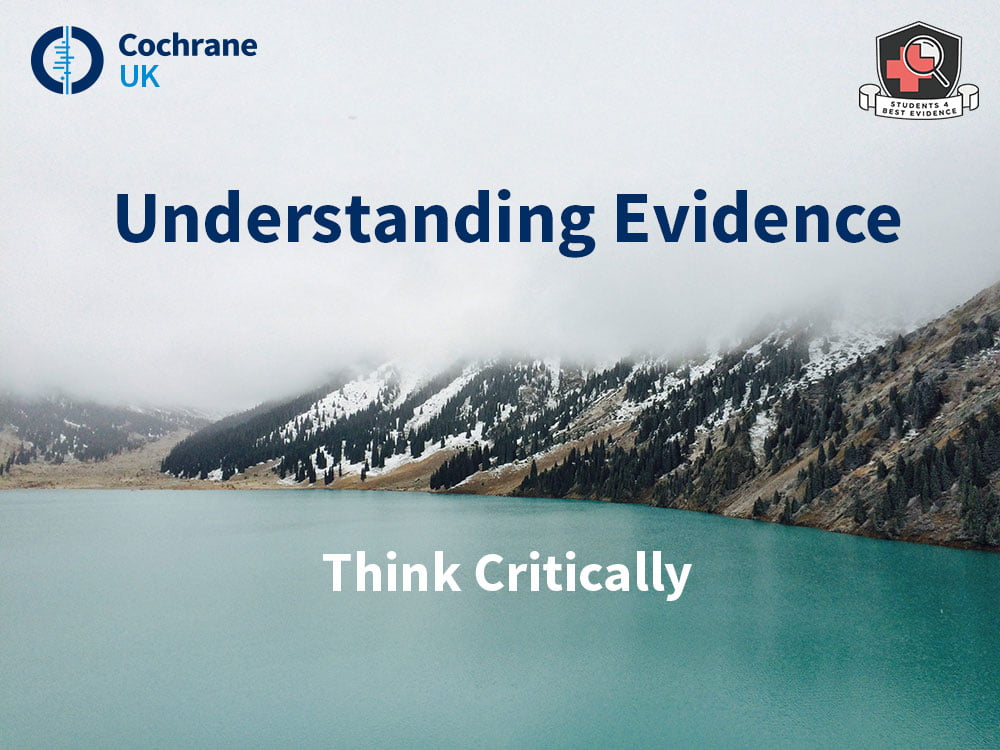Cochrane UK’s Director, Martin Burton, introduces our blog series on Understanding Evidence, created in partnership with Students 4 Best Evidence.
Page last checked 4 April 2023
Life is full of choices, and choice is important. Choosing different options when it comes to health care – particularly your own health care – is a serious matter. You don’t want to get it wrong.
Who needs to understand evidence?

I have sometimes thought that when patients are sitting in the waiting room of my outpatient clinic I should offer them a choice of consultation style. When they come and see me, do they want a rather old-fashioned, paternalistic, ‘doctor knows best’ type of consultation? One where I listen to them and then prescribe a treatmentSomething done with the aim of improving health or relieving suffering. For example, medicines, surgery, psychological and physical therapies, diet and exercise changes. or other course of action. Or do they want the opposite; to be presented with a complete set of options and choices, a set of internet references and bundle of written materials so they can go away and make up their own minds.
In my view, the optimal consultation involves “shared decision-making”. One in which I and the patient together consider their options in the context of their values and beliefs and their attitude towards riskA way of expressing the chance of an event taking place, expressed as the number of events divided by the total number of observations or people. It can be stated as ‘the chance of falling were one in four’ (1/4 = 25%). This measure is good no matter the incidence of events i.e. common or infrequent. and uncertainty. Both of us need to understand the evidence relating to the decisions that are being made. Evidence for example about the effectivenessThe ability of an intervention (for example a drug, surgery, or exercise) to produce a desired effect, such as reduce symptoms. (or otherwise) of different treatments and the risks associated with those treatments. Evidence too about the accuracy of diagnostic tests and about prognosis. And perhaps sometimes – and maybe increasingly – evidence about the “cost-effectiveness” of different options.
All this requires a clear understanding of evidence. In a particular circumstance what is good evidence and what is bad? Indeed, what do we mean by ‘good’ and ‘bad’ in this situation. The term “evidence-based” is bandied around a lot these days. I suspect not always appropriately.
Towards a better understanding
We are sharing a series of blogs to better help readers understand the use of evidence. The principles of evidence-based medicine dictate that ‘current best evidence’ should be brought to bear ‘conscientiously, explicitly and judiciously’ in making healthcare decisions.
‘Best evidence’ may come from a variety of sources. Systematic reviewsIn systematic reviews we search for and summarize studies that answer a specific research question (e.g. is paracetamol effective and safe for treating back pain?). The studies are identified, assessed, and summarized by using a systematic and predefined approach. They inform recommendations for healthcare and research. of randomisedRandomization is the process of randomly dividing into groups the people taking part in a trial. One group (the intervention group) will be given the intervention being tested (for example a drug, surgery, or exercise) and compared with a group which does not receive the intervention (the control group). controlled trialsA trial in which a group (the ‘intervention group’) is given a intervention being tested (for example a drug, surgery, or exercise) is compared with a group which does not receive the intervention (the ‘control group’). (RCTs) – such as those produced by Cochrane and published in the Cochrane Library – rank highest in the evidence hierarchy. Followed by RCTs themselves and then studies of other designs. Expert opinion and “mechanism-based reasoning” rank lowest. Understanding reports of systematic reviews, RCTs and other studies is critical. Unfortunately, just because something is published – on paper or on the internet – doesn’t mean you can believe it.
We hope this series will allow you to hone your skills so you can look critically at evidence and understand its strengths and weaknesses. A better understanding of evidence should – hopefully – allow you to make better choices about your own health care, or that of your family or patients. It should also help you, on a day-to-day basis, to look critically at news stories about health and to be rightly sceptical when things are labelled “evidence-based”.
Read all of the Understanding Evidence blogs here



I hope you will be candid about the limitations of RCTs (and systematic reviews of RCTs). They are a gold standard for a particular type of intervention – typically where one thing can be varied and everything else can be held constant or adjusted for, most obviously prescribing a drug. They are not that good for understanding the impact of policy changes (introducing a sugar tax or imposingf mandatory seat belts) or the emergence of new technologies (the rise of e-cigarettes or personal fitness monitors – I mention these because there have been misleading RCTs about both).
As soon as behaviour change is involved many more factors and external influences come into play and it is rarely realistic or possible to control for them all.
very important matter indeed to both patients and clinicians.
Very good presentation today on shortcomings and misunderstanding from systematic review of oral immunotherapy at the FAAM meeting in Rome.
Rubbish in rubbish out! Need to critically examine the evidence and ensure homogeneity of the studies!
Too much is often claimed of Cochrane!
Excelente.
Nice one. Looking forward to this.